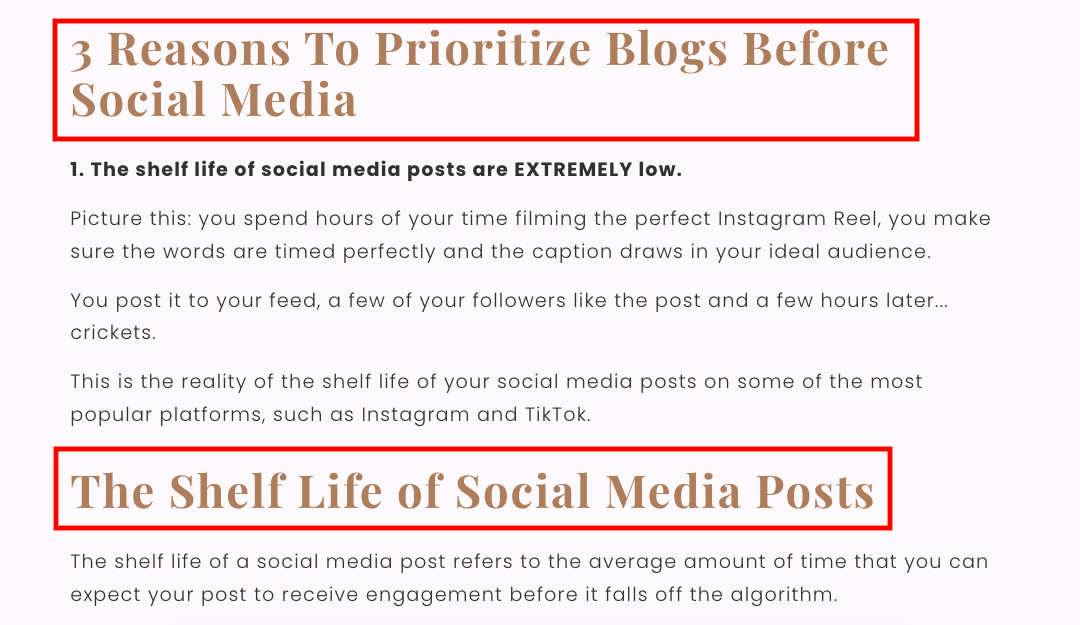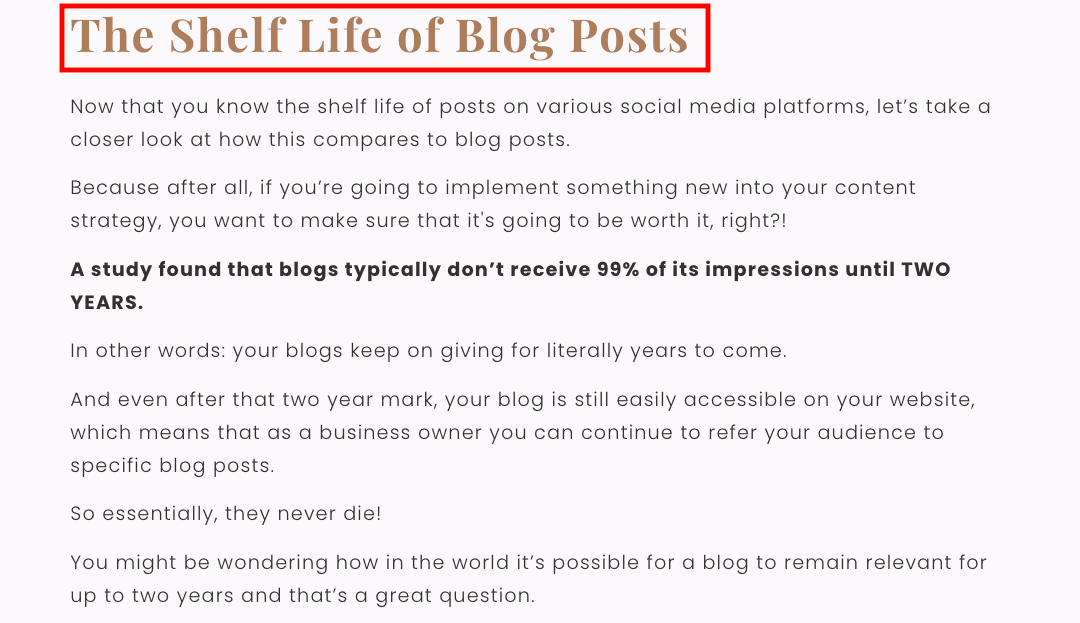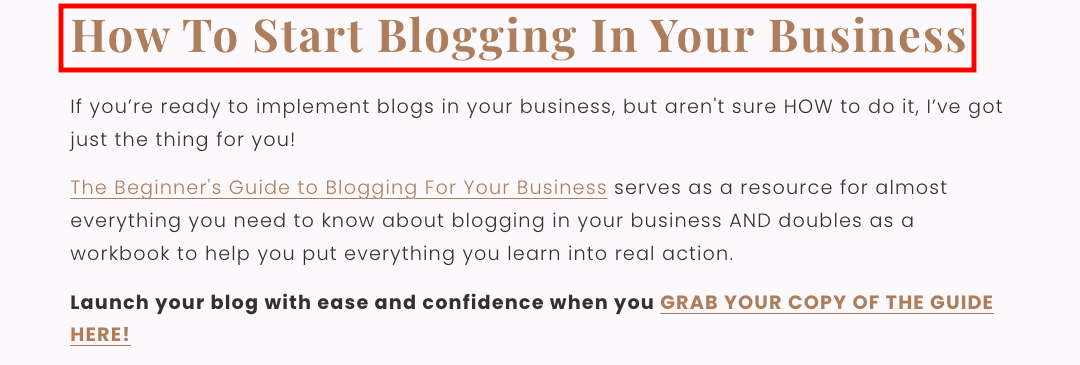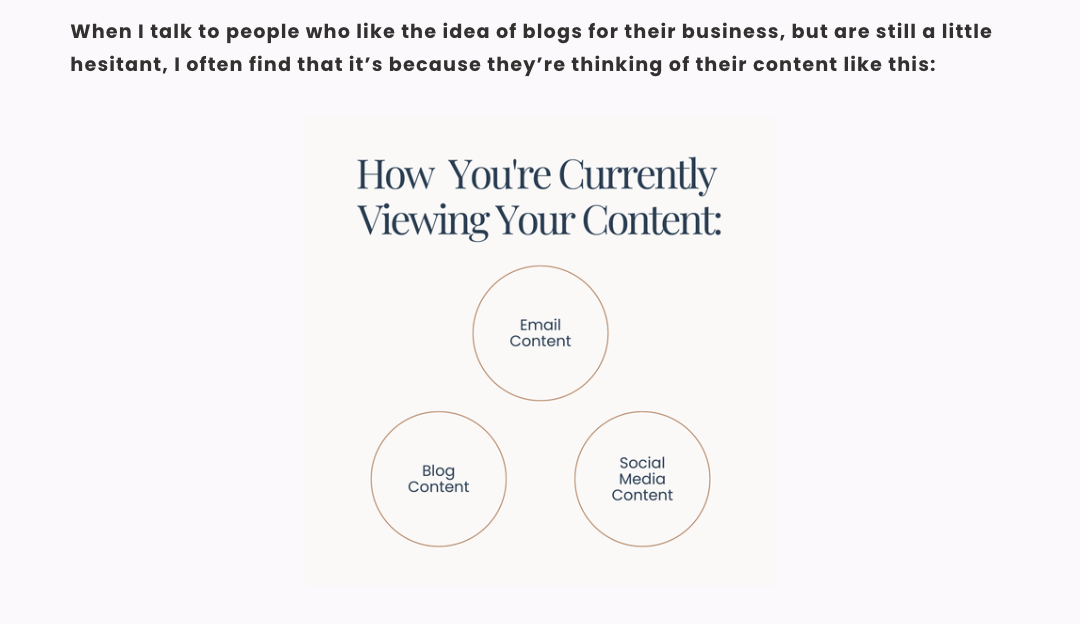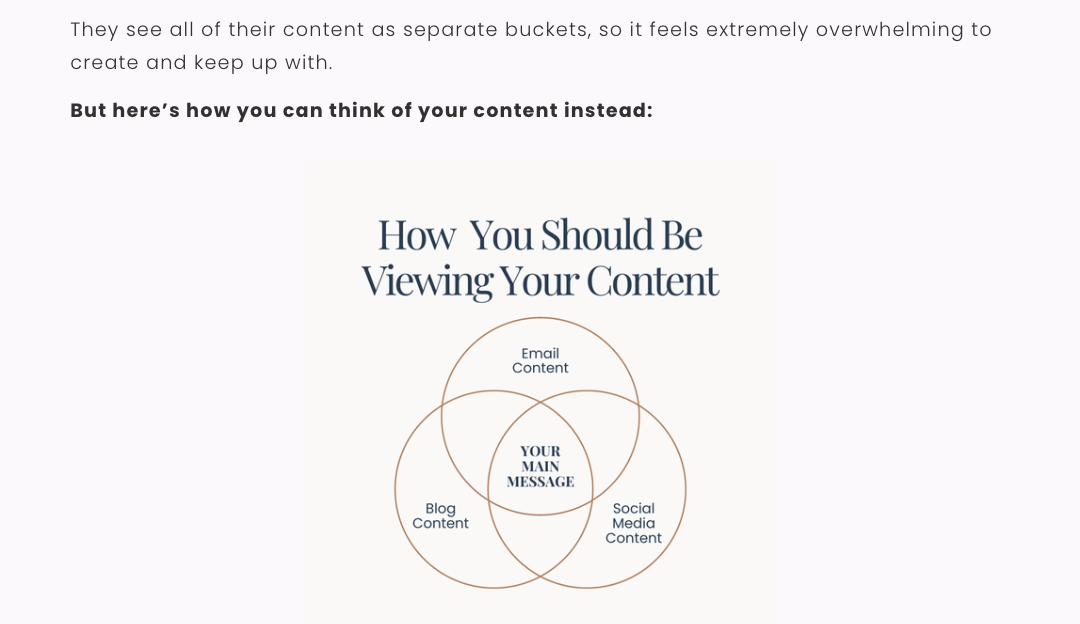The Anatomy of an Effective (and SEO Friendly) Blog Post
Blogging in your business is one thing, but blogging EFFECTIVELY is another.
As a society, overtime we’ve been trained to create content in a way that appeals to social media. Maybe you abbreviate words, use acronyms, let emojis do the talking, etc.
There are just some things that work well when it comes to social media content, but the same is true for blogs, too!
When you’re writing blogs for your business, you want to make sure they are written, titled and formatted correctly so that you get the most out of your long form content.
One of the greatest benefits of having long form content on your website is that it not only serves as a starting point for the rest of your content on other platforms, but it also boosts your SEO.
If you’re unfamiliar, SEO stands for search engine optimization and essentially it refers to your website standing in the eyes of Google and other search engines.
The more quality content you have on your website, the better your SEO rank.
Now, I don’t teach SEO in my business, because I believe there are far more reasons to implement blogs in your content marketing than just that – I give my spiel on that here – but that’s not to say SEO isn’t important!
It’s definitely something you want to pay attention to, but something I see happening a lot is that people think SEO is some huge, complicated thing that takes a genius to figure out.
While there are for sure some advanced SEO tactics that the average person may not know, there are also some incredible SEO basics that you can easily implement and one of those simply comes down to how you write your blog posts.
If you’re new to writing blogs in your business, you may have flashbacks to English class in high school where you were required to write a certain number of paragraphs with formal sentences.
OR you might find it difficult to go from writing for social media to writing long form content.
Wherever you fall, this blog post will provide you with an effective blog post anatomy that is valuable for your readers AND is SEO friendly.
The Anatomy of a Blog Post
Attention Getting, CLEAR Title with Appropriate Keywords
Titling your blog post shouldn’t be something you do at random. Your main title, meaning the thing that will display on your website and on Google, should do 3 things:
Grab the attention of your audience
Clearly convey what the blog is about
Include appropriate keywords so Google can index your content accordingly
A common mistake I see is that people will treat their blog post titles like email subject lines – while you DO want to capture the attention of your audience, you don’t want to leave out the clarity piece.
For example, let’s take this blog post of mine – it’s currently titled The Top 3 Questions I Get as a Blog Writer.
If I were to use that content for an email, the subject line might read: “Are you wondering these, too?”
That subject line works for an email, but it wouldn’t make for a very good blog title because I’m missing the clarity around what the blog is about and there are no keywords present to boost my SEO.
If you struggle with titling your blog posts, there are 4 titling styles that you can follow:
Quantify It – the brain likes to know what to expect, so when you clearly convey a specific number for someone, you’re grabbing their attention immediately and they know exactly what they’ll receive when they read your blog post.
Transformation – if people are searching for something, it’s likely because they need a problem solved. When you make your titles future paced, you call out what people are currently experiencing and help them see what’s possible in their future.
Educate – this one might seem obvious, but people love “how to’s” and step by step guides because again, you’re clearly solving a problem for them and giving them a quick win for a specific result.
Spill the Tea – when you use words like “revealed” or “insider’s secrets” it creates a sense of curiosity that excites people and makes them want more. People naturally want to know the tea!
To make this easy for you, I’ve created 20 free title formulas that you can grab HERE!
And if you’re in search of more information on proper keywords for SEO, I encourage you to learn from The Duo Collective – they’re my go-to’s for all things SEO and they have a great SEO basics course.
Introduction Paragraph
Before you dive into the main point(s) of your blog post, you want to tell the reader what they’re about to learn.
The main goal of a blog post introduction is to captivate and engage your reader and entice them to KEEP reading! The introduction is essentially your hook that sets the tone for the content that follows.
Additionally, the introduction should provide context, establish relevance and outline the main points so that the reader is very clear on what they’re about to learn and understand why the topic matters.
Subheadings
If your blog post has multiple points (and most of the time they will), this is where your subheadings will come into play.
The main purpose of subheadings in your blog posts is to enhance readability and improve the overall structure of your content. Subheadings break down the text into smaller, organized sections, making it easier for readers to scan and navigate through the entire post.
Subheadings also convey the main ideas or key points of each section in your blog post by providing a concise summary of the content within that section, allowing readers to quickly grasp the main concepts without having to read the entire blog post if they don’t need to.
Here’s a quick look at how I’ve utilized subheadings in a recent blog post:
Beyond providing organization, structure and improving the readability of your blog post, subheadings also heavily impact your SEO, which is why titling your subheadings strategically with keywords is so important.
By incorporating relevant keywords in subheadings, you can improve the visibility and search ranking of your blog post.
Main Body Text
The main body of your blog post will contain the bulk of your content and elaborate on the overarching topic at hand.
Each subheading will make up a portion of your main body text and should include relevant information for your main topic, examples, anecdotes, statistics and other insights that deliver value to your reader and guides them to a solution for their problem.
Visual Elements
Incorporating visual elements such as images, infographics, charts or videos when applicable can enhance your blog post and make your content more appealing.
When you include visual elements, it allows you to break up your main text and really illustrate the concepts that you’re trying to convey.
While visual elements can be valuable, you don’t want to overdo it. Make sure that you’re only using graphics and other images when it really makes sense to!
Here’s an example of how I’ve used images in a recent blog post:
SEO TIP: always add alt text to your images or graphics! You can find the section for alt text on the backend of your website when you upload your images. Here’s an article for further reference!
Conclusion and Call-to-Action (CTA)
Like any content, you want to make sure that you’re including a relevant CTA with the conclusion. In your conclusion section, you should summarize the key points discussed in your blog post and reinforce the main message or takeaway.
From there, you want to provide your reader with their next best step for more guidance or help that relates to the topic at hand.
For example, in this blog post I was educating my audience on 3 Reasons To Prioritize Blogs Before Social Media and the final CTA was opting into my Beginner’s Guide to Blogging For Your Business, so the reader could get started with blog content in their business with ease.
After providing them with valuable information in the blog post itself, I offered the next best step for them to take further action that was relevant to the content they just consumed.
Oftentimes people think that a CTA means directing people to buy something, but it’s important to know that’s not always the case. Common call-to-actions for your blog posts could be:
Opting into one of your lead magnets
Subscribing to your newsletter
Reading another blog post
Following you on social media
The whole point of this section of your blog post is to leave your readers with a sense of closure for the topic at hand and guide them to engage further with other content through your CTA.
Additional Blog Writing Resources For You
And there ya have it! An effective blog post anatomy that is also SEO friendly.
My hope is that you feel confident implementing long form content in your business through consistent blog posts.
If the idea of creating content in an effective blog format is still something you’re struggling with, I invite you to download The Beginner’s Guide To Blogging In Your Business – a comprehensive workbook designed to help you start blogging in your business with ease.
When you download the guide, you’ll receive:
✔️ 4 step blog content planning process
✔️ quarterly blog content calendar template
✔️ guidance on how to write & structure your blog posts
✔️ blog post outline template
✔️ 20 blog title formulas
✔️ 8 ways to repurpose your blogs on social media
After you download the guide, connect with me HERE to ask any questions OR schedule a 1:1 blog strategy and planning call so we can dive into your business specifically.


